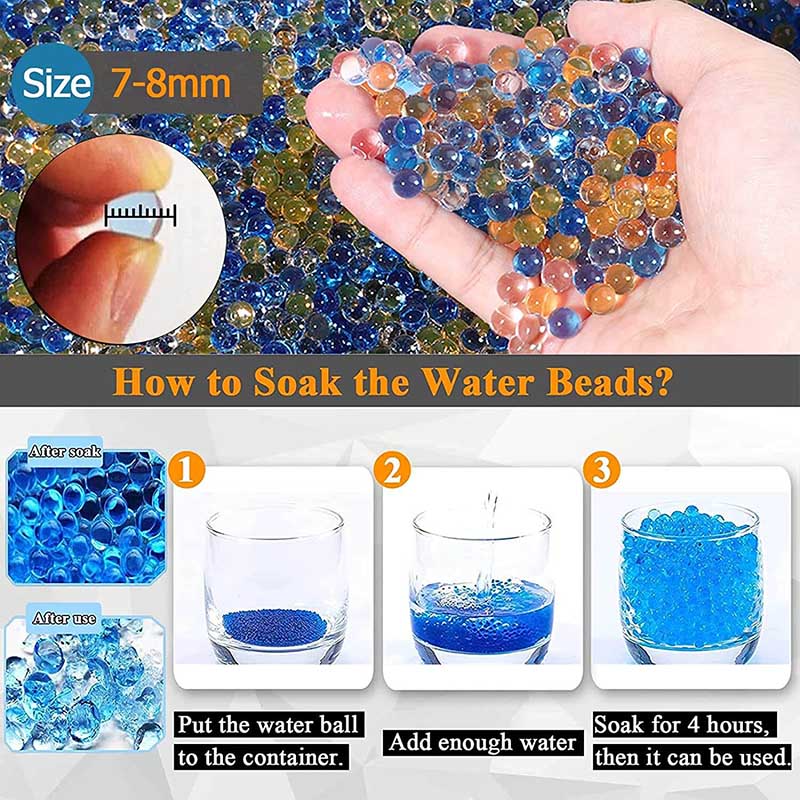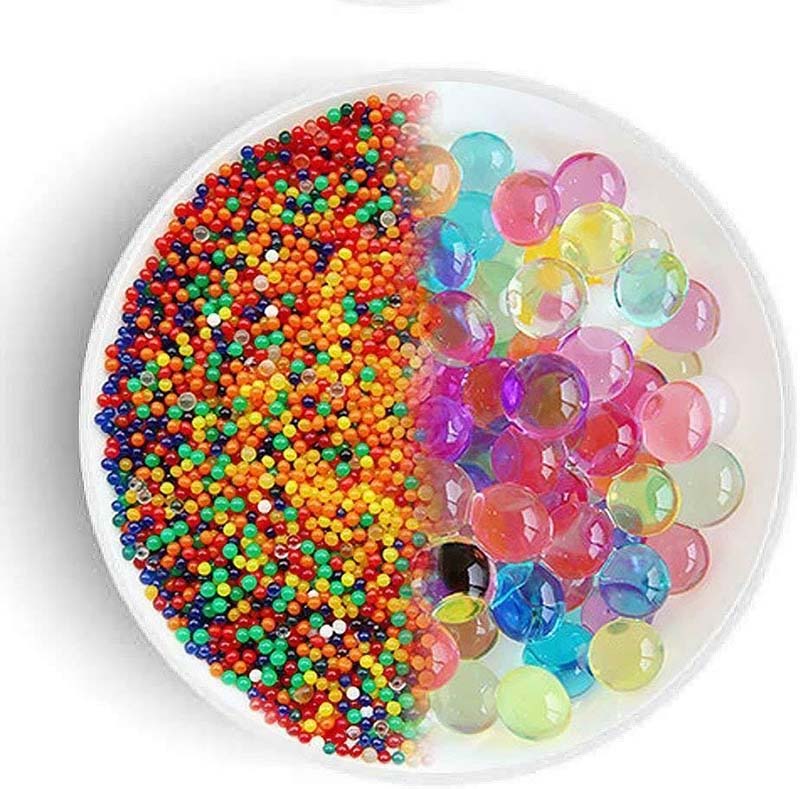6 Ways to Quickly Grow Gel Balls2024-04-08
Have you ever wondered how to make your gel balls grow quickly and efficiently? Gel balls, also known as water beads or hydrogel balls, are fascinating little spheres that expand when placed in water. In this article, we will explore various techniques and strategies to accelerate the growth process of gel balls, helping you achieve the desired size and texture in a shorter amount of time.
How Do Gel Balls Grow?
Gel balls are made from a special type of polymer that can absorb and hold water. When you put them in water, the polymers form a network of chains that expand, making the gel ball grow much bigger. This process is called hydration, and it's the key to growing gel balls.
The polymers in gel balls have parts that love water and attract water molecules. As the gel ball takes in more water, the polymer network gets bigger, and the gel ball grows. How much it grows depends on the type of polymer, how much polymer is in the ball, and the environment around it.
Gel balls can take a long time to reach their full size when left in water - sometimes hours or even days. By understanding what affects hydration and using different methods to speed it up, you can make gel balls reach their full size much more quickly.

1. Use Hotter Water
An easy way to make gel balls expand faster is to soak them in warm instead of cold water. The heated temperature gets the internal polymer strands wiggling with more energy, allowing them to uncoil further and create more space to absorb water rapidly.
Using pleasantly warm 90-100°F (32-38°C) water can cut the required soaking time for full growth in half compared to cold water. The balls will plump up to their maximum puffed size in no time when soaking in that warm water sweet spot.
Be careful not to use hot water that's too warm, as excessive heat can melt or mistreating the delicate gel balls. Never microwave or boil the water, as it can create super-heated zones that will just cook and ruin them.
The safest method is using warm tap water around 90-100°F if yours gets that warm. If not, mix some hot tap water with cold until a thermometer shows that ideal temperature before adding the dry balls. Keep checking so it doesn't overheat past 100°F.
You can also pre-warm water for 1-2 minutes until warm but not hot, then add cold to bring it down to the perfect 90-100°F hydration zone.
2. Gently Stir for Even Gel Ball Hydration
As gel balls soak up water and start expanding, they can form a hydrated outer coating that blocks more water from getting into the inner core. This outer shell plumps up first while the inside stays dry and unhydrated. Left alone, this leads to lopsided, unevenly puffed gel balls.
Periodically giving the gel balls a gentle stir helps break up that hydrated outer shell. It exposes the drier inner areas to the freshly soaked surrounding water, allowing moisture to penetrate evenly from the inside-out for nice round gel ball expansion.
But be really careful when stirring to avoid damaging the delicate hydrated surfaces, which can easily tear or break apart. Never vigorously swish or roughly stir the gel balls, as that can ruin hours of soaking effort.
The best way is using a soft utensil like a silicone spatula to very gently nudge and reposition the gel balls every 10-15 minutes. Just dip it in and give a gentle swirl with a light touch.
Or simply pick up and tilt the whole soaking container occasionally to tumble and re-expose the gel balls to fresh water.
3. Keep Gel Balls Fully Submerged
To reach their full expanded size, gel balls must remain completely underwater during the entire soak. Any part exposed to air, even briefly, will dry out and create an uneven, lopsided shape since that area can't properly hydrate and grow.
Staying fully submerged allows moisture absorption evenly from all sides for a perfectly round, plump shape. It also prevents the outer surface from drying prematurely and blocking further internal hydration.
As the gel balls soak up water and expand, the water level will gradually drop. To compensate, routinely add more water to keep the balls fully covered at all times.
Check the level every couple hours and top it off with room temperature (or warm) water whenever any part starts peeking through the surface. Add enough to re-submerge them with at least 1-2 inches over the top.
For really large batches, you may need to transfer the expanding balls midway to a bigger container so they stay totally underwater as they swell up.
4. Use Water-Absorbing Polymers for Faster Growth
Certain synthetic polymers are super absorbent and can soak up hundreds of times their weight in water molecules. Materials like sodium polyacrylate absolutely guzzle moisture.
Adding them to the gel ball soaking water creates an extremely water-saturated solution that helps maximize hydration and swelling of the gel ball structures.
For best results, use a very small amount of water-absorbing polymer - typically just 1/8 to 1/4 teaspoon per 1 cup of soaking water. Any more and it can make the solution too viscous.
First, add the dry polymer crystals or powder to the soaking water and mix or stir thoroughly until fully dissolved and the solution becomes thick and viscous. Then add your dry gel balls and soak as normal.
The hyper-hydrated polymer solution helps feed moisture continuously to the gel balls for faster absorption and growth. However, take care when stirring or removing them not to tear the delicate expanded structures.
Adding just a pinch of these affordable water-locking polymers can turbocharge your gel ball soak for plumper, super-sized hydrated spheres in less time. Just be cautious of the slippery thickened solution when handling your expanded gel balls.
5. Speed Up Growth with a Salt Solution
Adding a mild saltwater solution can actually turbocharge how fast gel balls absorb water and expand through something called osmotic pressure.
The dissolved salt makes the surrounding liquid a bit more concentrated than the plain fluid inside the gel balls. This concentration difference causes the gel's polymer strands to rapidly slurp up the saltwater from outside to try and even out the imbalance on both sides.
This fast influx of salty liquid allows the inner gel polymers to quickly unravel and create more space to accommodate a bunch of extra water molecules way quicker than in plain water alone.
To make an effective saltwater solution, just mix 1 teaspoon of basic table salt or rock salt into 1 cup of warm water until fully dissolved.
Start with this mild salt concentration and adjust from there if needed. Too much salt can actually backfire and work against expansion by making the surrounding fluid way too concentrated.
Make enough saltwater to fully submerge your batch of dry gel balls. Pour them in and they should visibly start chugging the salty liquid at a turbo speed compared to plain water.
6. Try Soap for Easier Water Penetration
Surfactants are chemicals that help liquids spread out and penetrate better into surfaces and materials. Common household soaps and detergents contain surfactants.
Adding a tiny amount of mild soap or surfactant to the gel ball soaking water can actually aid the water in more easily penetrating and dispersing into the inner polymer strands.
This results in faster, more uniform hydration throughout the entire gel ball structure instead of slower absorption just from the outer layers inward.
For experimenting, you just need an extremely small quantity of liquid dish soap or mild detergent - like a single drop per cup of soak water. Any more and the excess suds could interfere.
Avoid using concentrated surfactants or harsh cleaners which could potentially damage or degrade the gel material over time.
Start with just that tiny soap amount and see if it speeds up visible hydration during the first couple hours of soaking. If effective, the gel balls should expand more quickly and evenly compared to plain water alone.
Be sure to thoroughly rinse away any soapy residue once fully hydrated before using the gel balls for any projects or applications.

Maximize Gel Ball Growth Rapidly
How can you grow gel balls faster? The secrets to getting those mega-puffed gel ball spheres in record time? Warm 90-100°F water, and selectively using salt, polymers or a soap boost. Gentle periodic stirring ensures even expansion too. Keeping humidity high and balls fully submerged are musts. With these simple hydration hacks, you'll delight in their full plump potential way sooner. Try these easy tips to supercharge your gel ball growth today!
Read more:
- How to survive a water gun fight!
- Strongest splatter ball gun: your ideal choice for action
- Gel blaster vs. paintball: which hurts more?
- Company Info
- About Us
- Contact Us
- Customer Reviews
- Blogs
- Brands
- YouTube Videos
- User Center
- FAQ
- Forget Password
- My Orders
- Tracking Order
- My Account
- Register
- Affiliate
- Company Policy
- Locations We Ship To
- Payment Methods
- Shipping Policy
- Refund Policy
- Privacy Policy
- Terms of Service
- Disclaimer
- Contact Us
ZHENDUO Electornics Technology LLC
Address: 7200 MISSOURI AVE,Denver,CO,United States,80202
Contact number: (626) 215-2450
Email address: xiewentao@zhenduo.email


